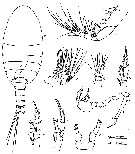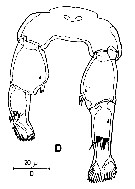|
|
 |
|
Calanoida ( Order ) |
|
|
|
Clausocalanoidea ( Superfamily ) |
|
|
|
Stephidae ( Family ) |
|
|
|
Stephos ( Genus ) |
|
|
| |
Stephos lucayensis Fosshagen, 1970 (F,M) | |
| | | | | | | Ref.: | | | Fosshagen, 1970 (p.38, figs.F,M); Huys & Boxshall, 1991 (p.49, 59, 78, 81, figs.F,M); Bradford-Grieve, 1999 a (p.25, Table1: Rem.) |  issued from : A. Fosshagen in Sarsia, 1970, 41. [p.40, Fig.2]. Female (from 24°34'40''N, 75°56'40''W): A, habitus (dorsal); B, A1; C, A2; D, Md; E, Mx1; F, urosome with fyaline sheath (lateral). Nota: A1 24-segmented. The genital segment is slightly more swollen on the left than on the right side; rows of fine spinules present dorsolaterally on the proximal part; a strong spine is situated midventrally, reaching from the genital orifice to the end of the segment; when carrying a spermatophore the genital segment is covered by a hyaline sheath of a very complex structure; the sheath seems to be essentially of the same shape in different animals but the position in which it is fixed can vary from specimen to specimen. The origin of this sheath is uncertain but it seems to be secreted from 2 gland-like structures, one on either side of the last prosomal segment next to the genital segment. The spermatophore, which is attached to the ventral side of the urosome, is very slender and flexible, and may be almost as long as the whole animal. The 4 terminal setae of the caudal rami are articulated.
|
 issued from : A. Fosshagen in Sarsia, 1970, 41. [p.41, Fig.3]. Female: A, Mx2; B, Mxp; C, P1; D, P2; E, P3; F, P4; G, P5. Nota: P5 3-segmented, asymmetrical, left leg longer than the right one; 2nd segments with inner margin convex and carrying distally a couple of spines; terminal segments with transverse rows of spines across the middle; the distal part of both legs flattened and almost fan-shaped, with a serrated outer margin. Male: H, habitus (dorsal); I, P5.
Nota: A1 24-segmented but equipped with more aesthetascs along the anterior margin than in female. A2, mouthparts, and P1-P4 as in the female. P5 powerfully developed as a grasping organ; right leg 4-segmented, ending in a simple spiniform segment, the distal part of which is straight while the proximal part is curved inwards, the penultimate segment is very elogated and has an outer, flattened, proximal part with a short spine; the inner distal corner of the segment possesses a blunt, saddle-like process, the distal part of which lies at right angles to the main axis of the segment; left leg has a tumid, strongly developed, penultimate segment; the outside of the segment bears 4 irregular, spiniform processes of unequal length; the terminal segment bears 3 long, irregular processes of approximately equal length, two of which are pointed and smooth, and the third lamelliform with an inner, comb-like row of stout spines.
|
 issued from : R. Huys & G.A. Boxshall in Copepod Evolution. The Ray Society, 1991, 159. [p.78, Fig.2.2.25, D]. Female (from Bahamas: 24°34'N, 75°56'40°W): P5.
|
 issued from : R. Huys & G.A. Boxshall in Copepod Evolution. The Ray Society, 1991, 159. [p.81, Fig.2.2.28, A-B]. Female:A-B, genital double somites (ventral and lateral respectively).
|
 issued from : R. Huys & G.A. Boxshall in Copepod Evolution. The Ray Society, 1991, 159. [p.78, Fig.2.2.25, B]. Male: P5.
| | | | | NZ: | 1 | | |
|
Distribution map of Stephos lucayensis by geographical zones
|
| | | | Loc: | | | Bahamas (Andros Is). | | | | N: | 2 | | | | Lg.: | | | (554) F: 0,71-0,63; M: 0,68-0,58; {F: 0,63-0,71; M: 0,58-0,68} | | | | Rem.: | Depth: 4-5 m, on bottom.
After Bradford-Grieve (1999 a, p.25) this species belongs to type III (see Genus Stephos). | | | Last update : 14/08/2015 | |
|
|
 Any use of this site for a publication will be mentioned with the following reference : Any use of this site for a publication will be mentioned with the following reference :
Razouls C., Desreumaux N., Kouwenberg J. and de Bovée F., 2005-2025. - Biodiversity of Marine Planktonic Copepods (morphology, geographical distribution and biological data). Sorbonne University, CNRS. Available at http://copepodes.obs-banyuls.fr/en [Accessed December 04, 2025] © copyright 2005-2025 Sorbonne University, CNRS
|
|
 |
 |








